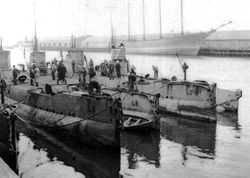USS L-6 (SS-45)
.jpg) USS L-6, possibly at the California Shipbuilding Company at Long Beach, California, in 1917. | |
| Career | |
|---|---|
| Name: | USS L-6 |
| Builder: | Craig Shipbuilding Company, Long Beach, California |
| Laid down: | 27 May 1914 |
| Launched: | 31 August 1916 |
| Commissioned: | 7 December 1917 |
| Decommissioned: | 25 November 1922 |
| Fate: | Sold for scrap, 21 December 1925 |
| General characteristics | |
| Type: | L class submarine |
| Displacement: | 456 long tons (463 t) surfaced 524 long tons (532 t) submerged |
| Length: | 165 in (4.2 m) |
| Beam: | 14 ft 9 in (4.50 m) |
| Draft: | 13 ft 3 in (4.04 m) |
| Propulsion: | Diesel-electric |
| Speed: | 14 knots (26 km/h; 16 mph) surfaced 10.5 knots (19.4 km/h; 12.1 mph) submerged |
| Complement: | 28 officers and men |
| Armament: | • 4 × 18 in (457 mm) torpedo tubes, 8 torpedoes • 1 × 3"/23 caliber deck gun |
USS L-6 (SS-45) was an L-class submarine of the United States Navy. Her keel was laid down on 27 May 1914 by Craig Shipbuilding Company in Long Beach, California.
The L-boats designed by Lake Torpedo Boat (L-5 through L-8) were built to slightly different specifications from the other L-boats, which were designed by Electric Boat, and are sometimes considered a separate L-5 class.
L-6 was launched on 31 August 1916 sponsored by Mrs. William R. Monroe, and commissioned on 7 December 1917 with Lieutenant H. B. Berry in command.
Service history

After exercises along the West Coast, L-6 departed Pacific waters on 20 April 1918, arriving Charleston, South Carolina, on 10 June. Following a brief overhaul, the submarine patrolled off Charleston until she sailed on 15 October for the eastern Atlantic. Arriving Ponta Delgada, Azores, in early November, L-6 joined Submarine Division 6 just prior to the signing of the Armistice with Germany on 11 November.
After making stops in Caribbean Sea and Central American ports, L-6 arrived San Pedro, California, on 14 February 1919, completing one of the best long-distance seagoing performances of the United States's youthful submarine force. From 1919 to 1922, she remained on the West Coast, experimenting with new torpedoes and undersea detection equipment. L-6 was placed in commission, in ordinary, on 24 March 1922; returned to full commission on 1 July; and sailed for the East Coast the same month. Upon arrival Hampton Roads, L-6 decommissioned on 25 November 1922, and was sold to M. Samuel and Sons on 21 December 1925 for scrapping.
References
- This article incorporates text from the public domain Dictionary of American Naval Fighting Ships. The entry can be found here.
External links
- Photo gallery of USS L-6 at NavSource Naval History
| ||||||||||||||||||